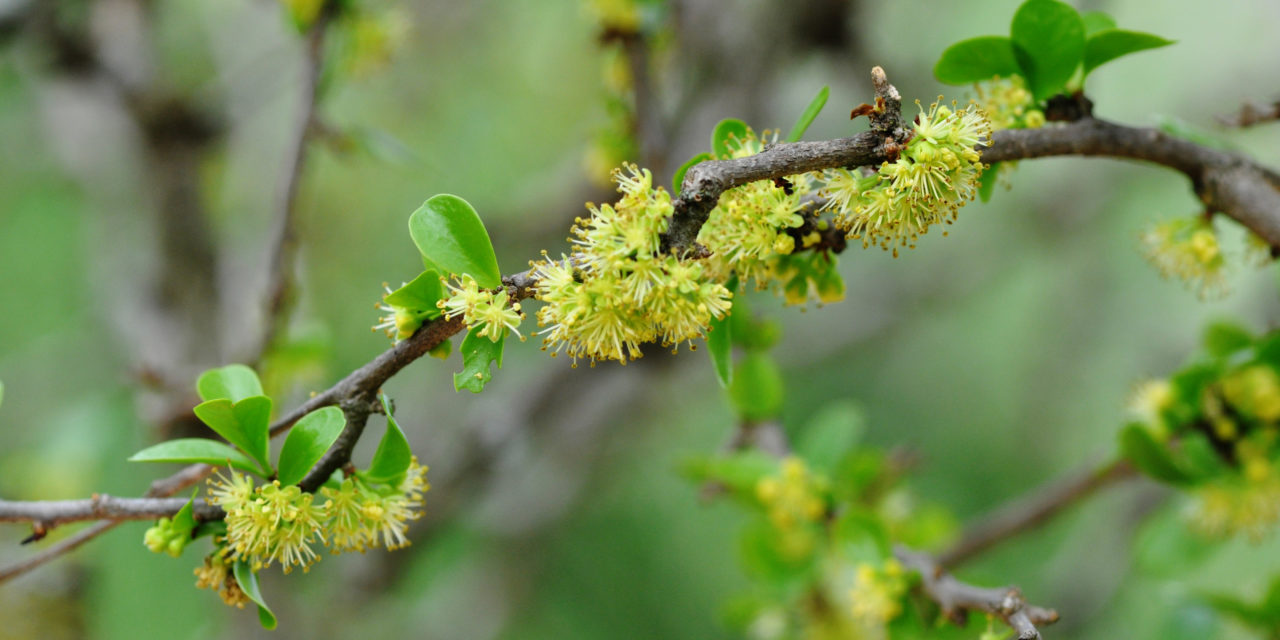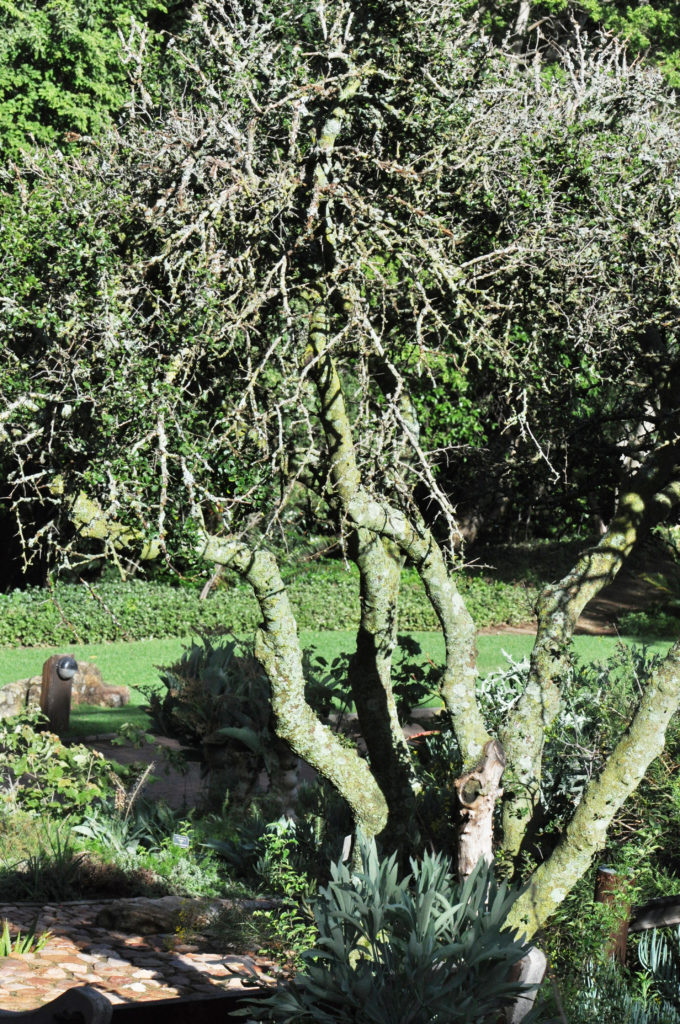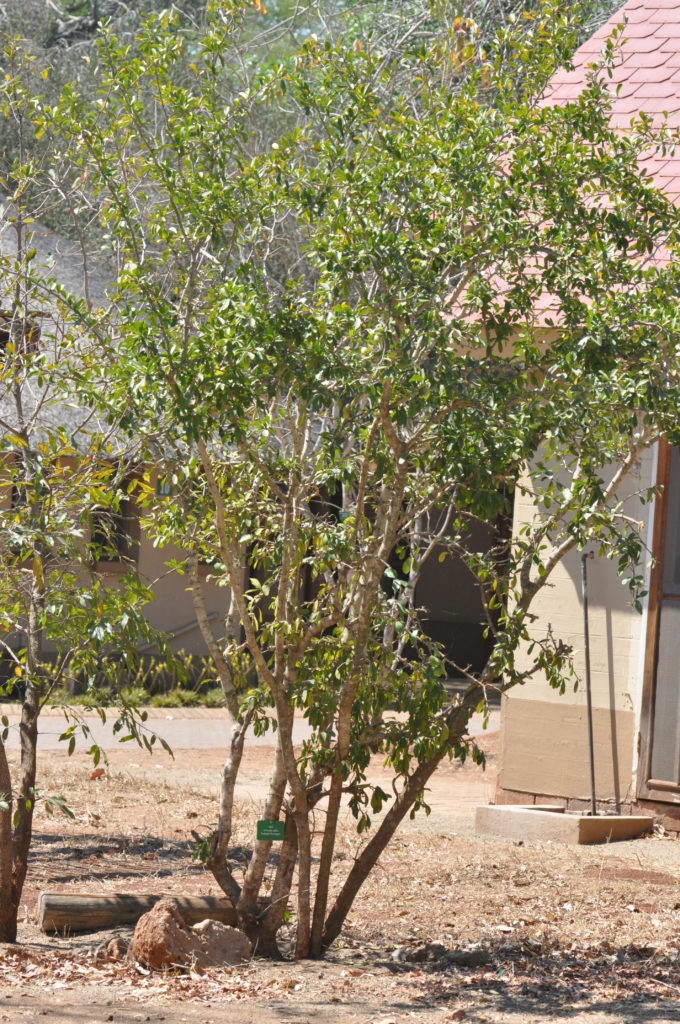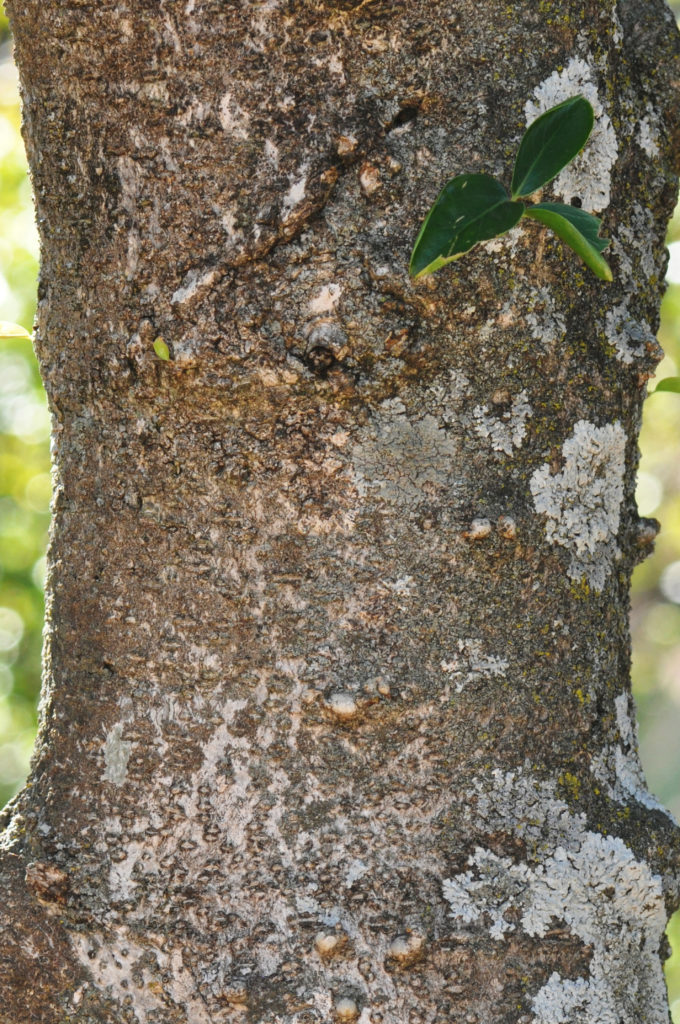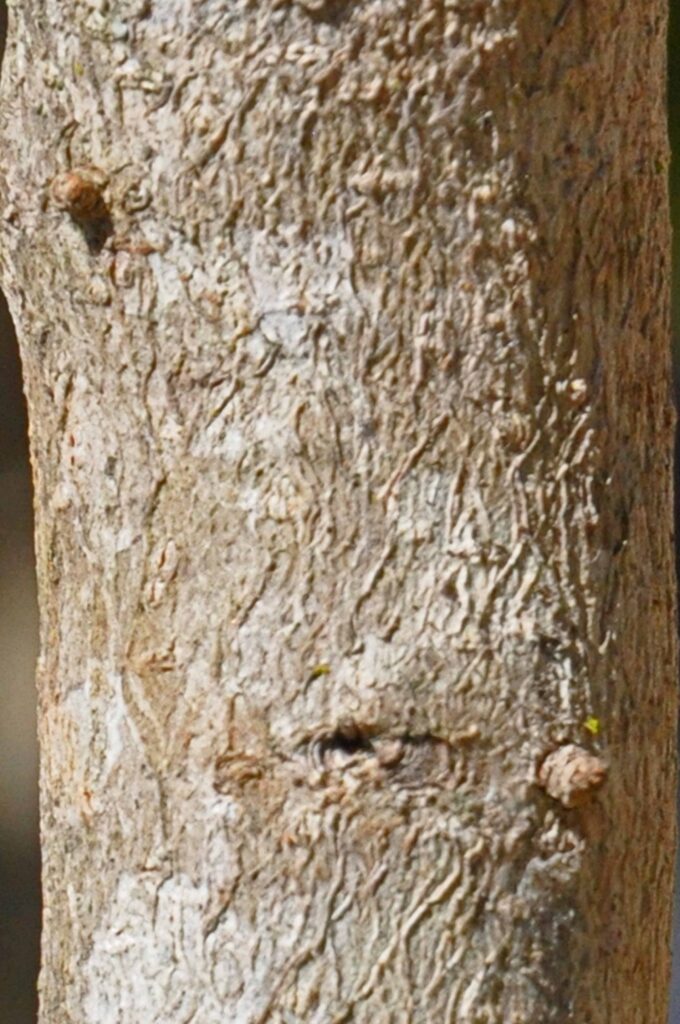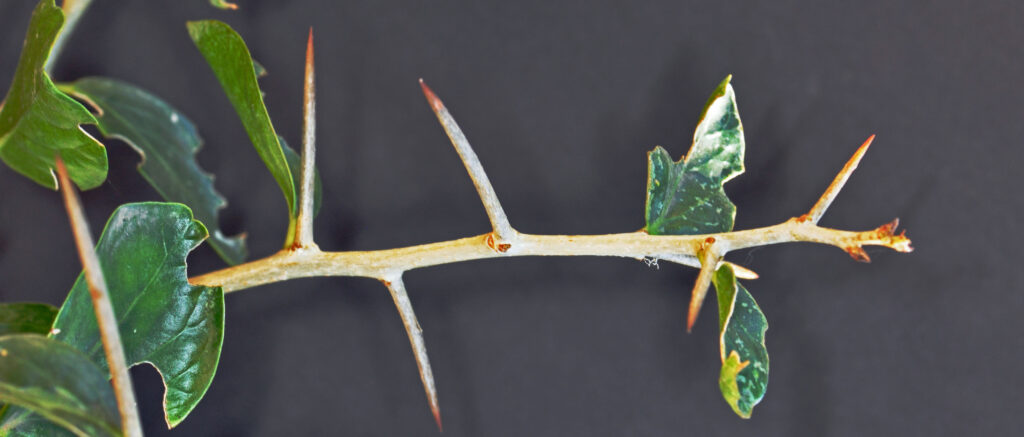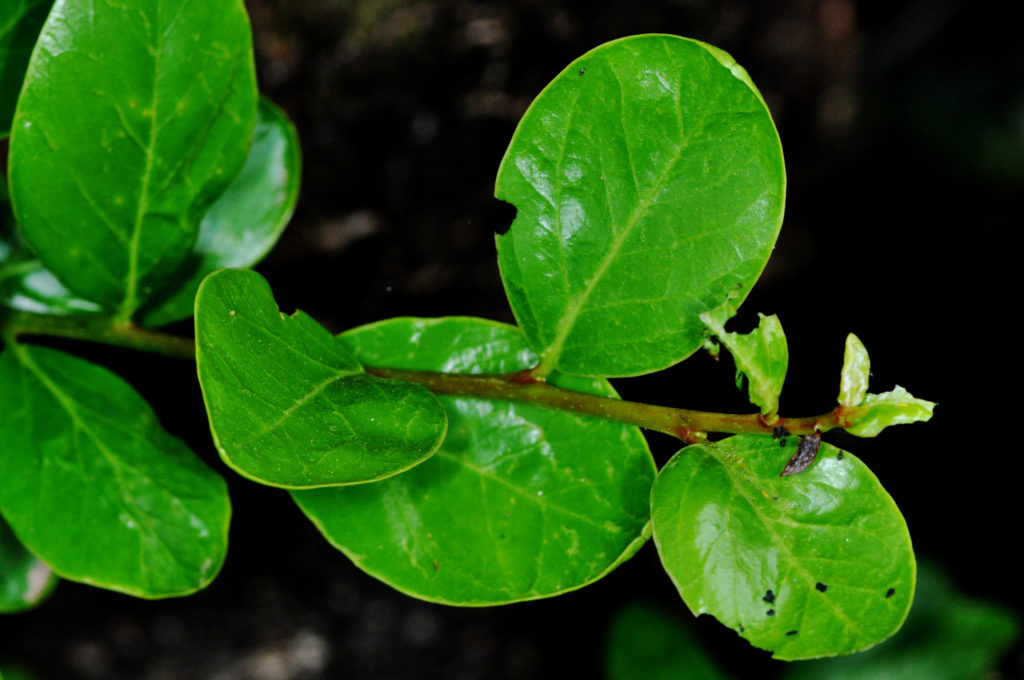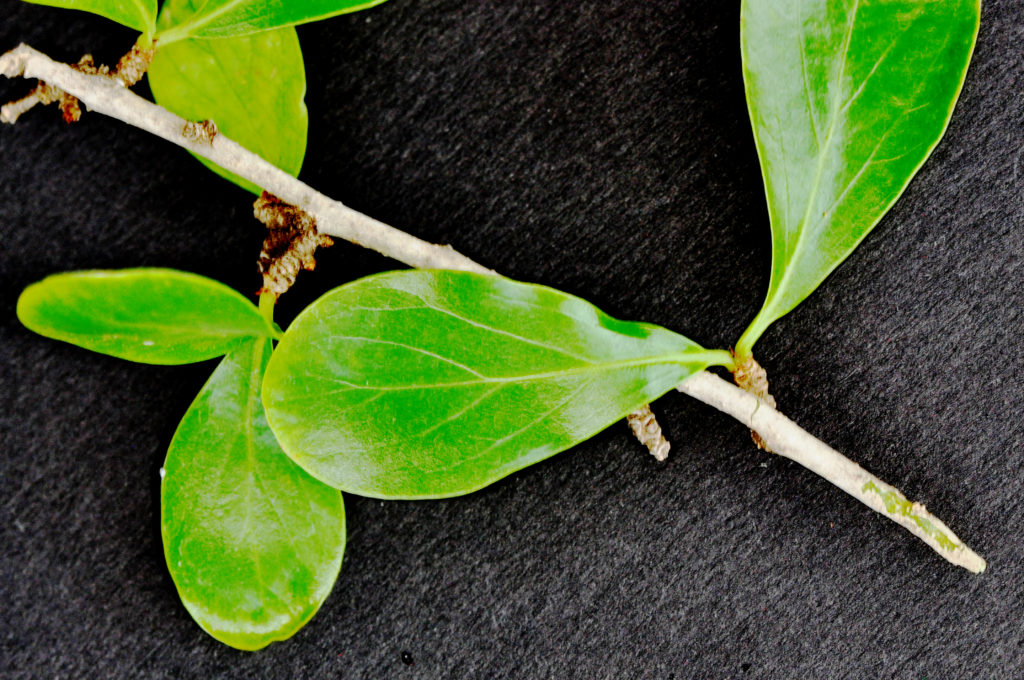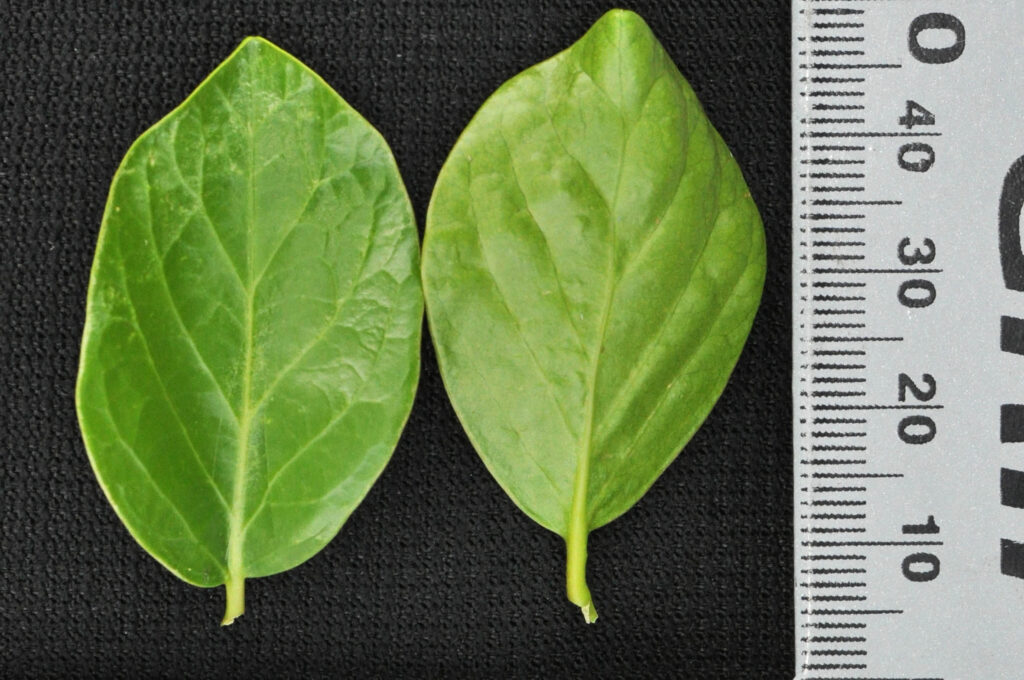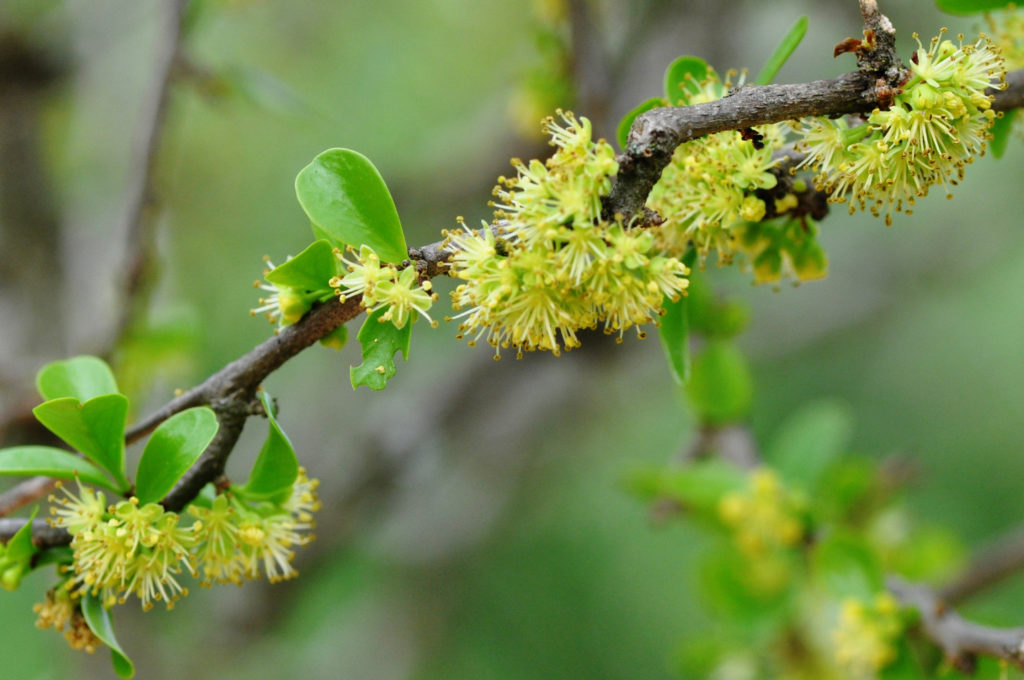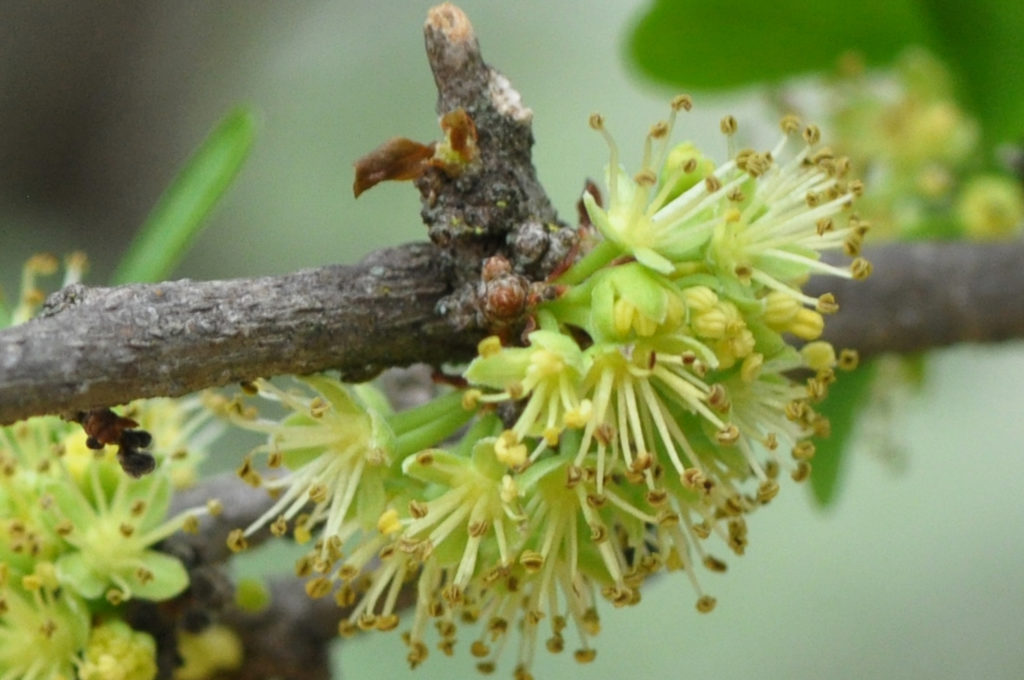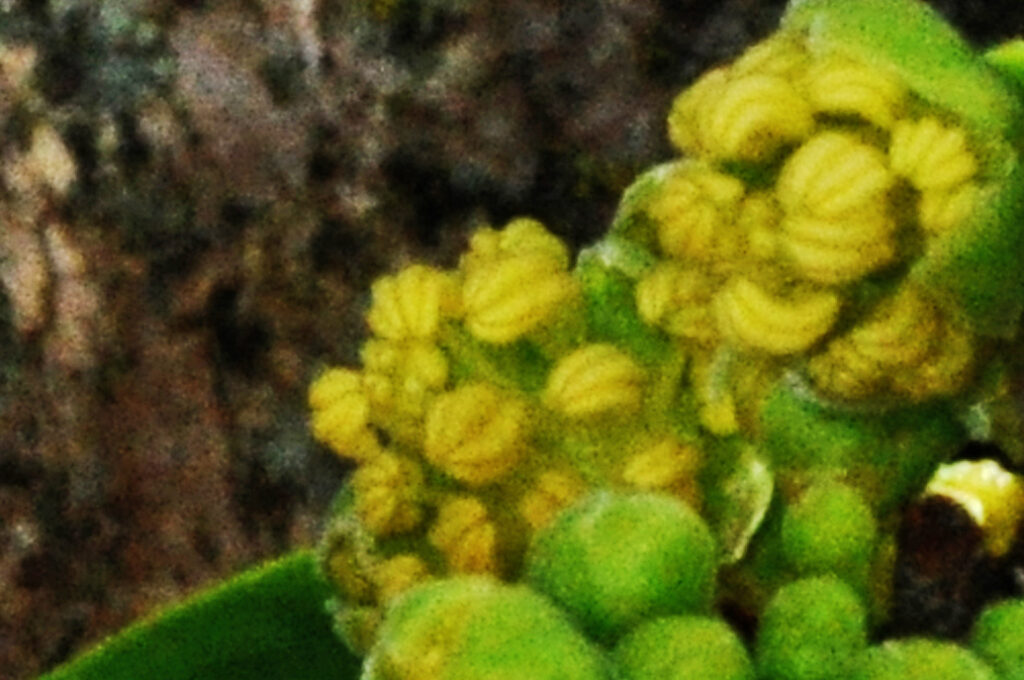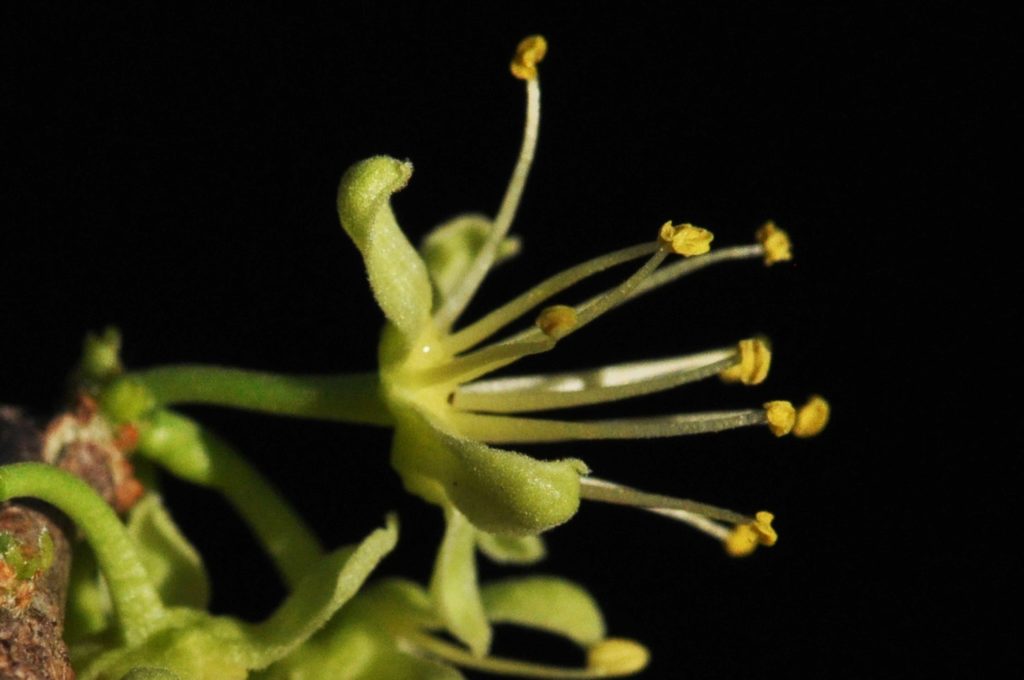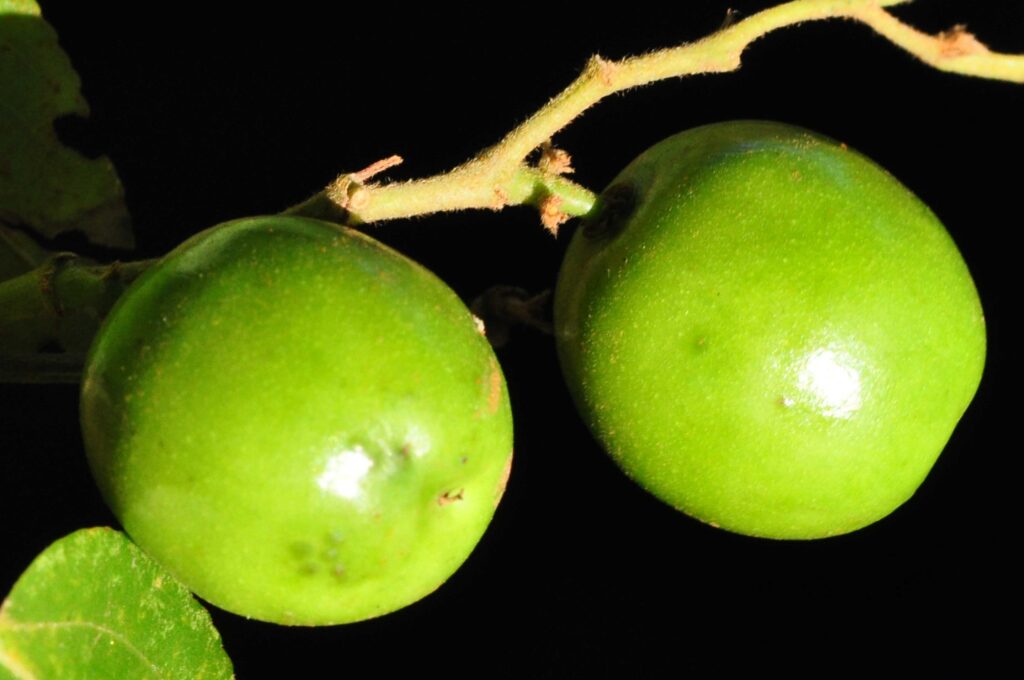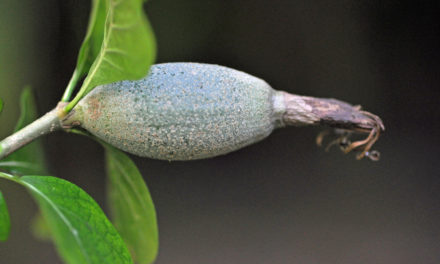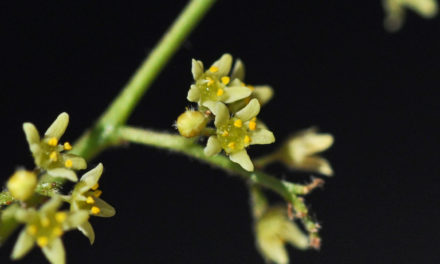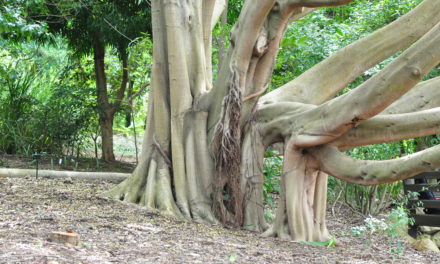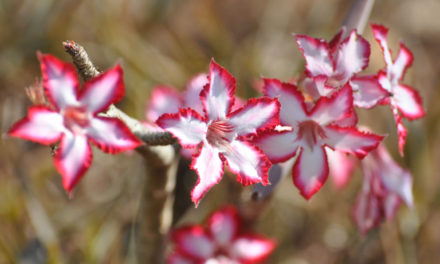General Info – summary
This deciduous Tree + rounded crown is up to 9m high. Single long spines are present. Simple, entire usually obovate and alternate Leaves are 3-5 veined near the base, lack stipules & margins are entire. Small, creamy, regular & dioecious Flowers have pedicels & lack petals. Male has 10 stamens with long filaments. Female with a superior 1-chambered ovary. Fruit is a large, edible berry with many seeds.
Description
Dovyalis caffra
Previous Name: Aberia caffra, Aberia edulis.
SA Tree No. 507.
Common names: (Afr) Appelkoosdoringa, Kei-appel, Wilde-appelkoos. (Eng) Dingaan’s Apple, Dingaan’s Apricot, Kei-apple, Large Kei-apple, Wild apricot. (isiNdebele) Umkokolo, Umqokolo. (isiXhosa) Incagolo, Umqokolo. (isiZulu) Umbambane, Umhlabankunzi, Umqokolo, Uqokolo. (Northern Sotho) Mahlono, Motlhono. (siSwati) Intapane, Sangongongo. (Tshivenda) Mutunu, Muvhamba-nguvho. (Xitsonga) N’wambula.
Family: Salicaceae: (Willow family – includes the exotic poplar trees (genus Populus), willows, aspen, and cottonwoods). The family Salicaceae has recently been expanded and includes 55 genera and 1 000+ species. Trees may be deciduous or evergreen. Simple, alternate and stipulate Leaves may have serrate or dentate margins – in which case toothed margins all have veins entering each tooth. The bark often containing Salicin (a bitter alcoholic glucoside related to aspirin). This glucoside can be used as an anti–inflammatory. However, it may cause a skin allergy. Flowers may be dioecious to hermaphrodite and occur in inflorescences (Catkins with stamens in male flowers and carpels in female flowers). A normal perianth may be absent. A bract subtends each flower. There are 2 to many Stamens with long filaments. The superior Ovary has 2-4 carpels. Flowers are wind pollinated. Fruit is variable with many small, wind dispersed Seeds. Local genera on this website include Dovyalis, Oncoba, Salix and Scolopia.
Name derivation: Dovylis – spear (Greek) referring to the spines. caffra – from the Eastern Cape. There are 6 species of Dovyalis in southern Africa.
Conservation: National Status: L C. (Least Concern). Assessment date: 2005 (W. Foden and L. Potter).
Tree
A dense, rounded crown is present on the small Tree that is up to 3 to 8m (usually less) high. It may also be a much-branched shrub (photos 123 & 513). On larger trees, the Stem (main axis of the plant, the leaf and flower bearing as distinguished from the root-bearing axis) may be crooked. The smooth Bark is grey to silvery (photo 99). As it ages, it becomes rough and longitudinally fissured (a long narrow opening; a crack or cleft). The bark may flake into square sections on large trees. On young trees, the bark may be light or shiny (photo 508) and may become corky as it ages. When present, the light grey, stout, almost straight and sharp Spines are not in pairs and alternate in young shoots (photo 224). Each spine up to 7cm long (photo 510 under Leaves) and may end in a dark red tip (photo 224). Many spines emerge mainly from youngish branches. Taller trees have fewer spines. Lenticels (a usually raised corky oval or elongated area on the plant that allows the uncontrolled interchange of gases with the environment) are visible on younger branches.
- 123. 2016/12/13 Walter Sisulu NBG. Photo: David Becking.
- 513. 2014/09/08 Lower Sabi KNP. Photo: David Becking.
- 99. 2014/06/03 Walter Sisulu NBG. Photo: David Becking.
- 508. 2014/09/08 Lower Sabi KNP. Photo: David Becking.
- 224. 2014/06/03 Walter Sisulu NBG. Photo: David Becking.
Leaves
The simple, shiny, thick, leathery and relatively small Leaves are up to 5 x 3cm on this deciduous tree (photo 281). They may be larger on coppice growth (case when stems are cut or burned it causes regrowth from the stump or roots). Leaves are glossy green above and slightly lighter below. They often occur in tight clusters, on dwarf spur-branchlets (photo 700), close to a stout spine (photo 510). On young branches, the leaves may be alternate. Leaf shape is usually obovate (egg-shaped – with the narrower end at the base like an upside down egg – photo 700) or elliptic in shape. Apart from young leaves being sparsely hairy, the mature leaves are hairless. Three to five Lateral veins are visible on both sides – protruding below and sunken above (photo 281). The Midrib becomes less conspicuous closer to the leaf apex (photo 281). 3 veins may be visible arising from the tapering to narrowly rounded leaf Base and here it may be. The base may also be asymmetric (not equal to the opposite side – photo 700). The Apex is rounded (photo 700) or notched. The Margins are untoothed, slightly rolled under and entire (with a continuous margin, not in any way indented). The short Petiole (leaf stalk) is 2-5mm long (photo 281). Stipules (basal appendage of the petiole) are absent. Hair-tuft domatia (a tiny chamber produced by plants that house arthropods. To the naked eye the domatia appear as small bumps) may be present in vein axils.
- 280. 2015/09/15 Walter Sisulu NBG. Photo: David Becking.
- 509M. 2014/09/08 Lower Sabi KNP. Photo: David Becking.
- 510. 2014/09/08 Lower Sabi KNP. Photo: David Becking.
- 700. 2014/10/30 Pretoria NBG. Photo: David Becking.
- 281. 2015/09/15 Walter Sisulu NBG. Photo: David Becking.
Flowers
The trees are dioecious (unisexual floral structures with male and female parts on separate plants). The creamy green, non-decorative, nectar rich Flowers are small but worth looking at through a hand lens. These insect pollinated flowers are actinomorphic (Regular, symmetrical. Flowers are vertically divisible into similar halves by more than 1 plane passing through the axis). The Calyx has 3-7 deeply lobed green Sepals (photos 603 & 597). The Corolla is absent from all genera of Dovyalis (no petals – photo 597). All flowers rest on a Pedicel (stalk of a single flower – photos 603 & 597) – up to 1cm long and surrounded at the base by small, creamy green, hairy, scale like bracts. These flowers occur in leaf axils or on side shoots.
Each Male flower is about 3mm long and occur in dense clusters of up to 10 flowers (photo 603). Prior to emerging, the bilocular Anthers (photo 597) resemble minute bananas (photo 276). The sex of the flowering tree is easy to determine because of large group of these young banana-like anthers in the male flowers. They eventually extend well beyond the calyx (photo 603). The anthers change from bright yellow to brown (photo 603). Female flowers occur singly or in groups of up to 3. Flowers have a single Pistil (a unit of the Gynoecium, the female element of the flower, composed of the Ovary, Style and Stigma) with a superior, 1-chambered Ovary. The Styles are channelled. (Sep-Jan). (Sep-Jan).
- 601. 2015/09/22 Walter Sisulu NBG. Photo: David Becking.
- 603. 2015/09/22 Walter Sisulu NBG. Photo: David Becking.
- 276. 2015/09/15 Walter Sisulu NBG. Photo: David Becking.
- 597. 2018/09/18 Walter Sisulu NBG. Photo: David Becking.
Fruit
The velvety, almost spherical, fleshy and edible Fruit is a Berry (pulpy, indehiscent fruit like a grape or tomato – photo 01). It is large – up to 6cm in diameter, initially green and somewhat shorter than wide. The mature Fruit is a bright yellow-orange colour and has a soft, thin skin surrounding a soft pulp. It ends with a persistent, wispy Style (photo 01). Fruit takes about 4 months to develop. Imbedded in the fleshy pulp are many woolly, elliptic Seeds each up to 1cm long. The Testa (seed coat) is leathery. (Nov-Mar).
- 01 Pretoria NBG. Photo: David Becking.
Distribution & Ecology
This Plant grows naturally in dry, hot conditions in the bushveld, in open woodlands, in areas at a wide range of altitudes up to 1 400m and is common on rocky hillsides. They develop in areas of moderate rainfall and are often associated with termite mounds. Trees occur naturally in the Western Cape, Eastern Cape – common and abundant e.g., the Kei River, along the east coast, through KwaZulu-Natal, Mpumalanga, Limpopo, Swaziland, extreme southern Mozambique, and into southern Zimbabwe and eastern Tanzania. The tree is both cold and fire resistant and may grow singly or in clumps. The Spines do provide some protection from animals. Antelope browse the Leaves and young shoots. The Flowers produce large quantities of Nectar, which is also utilised by birds and honeybees.
Ethnobotany
This hardy drought resistant Tree is a good garden prospect. Seeds soon lose their vitality and should be germinated soon after shedding and being dried. This can be a smelly process. Growth rate is about 60cm per year. Both male and female trees are necessary for fruit production. Cuttings are also successful if treated correctly with hormones. In this respect, selecting separate male female cuttings is critical if fruit is required. Young plants may be frost sensitive. Roots are not aggressive. Dense Wood is light yellow, close grained and tough but subject to cracks and little used. Fruit is produced after about 5 years and may be attacked by fruit fly. The good fruit is slightly acidic and can be eaten fresh. It also makes excellent jelly and jam. The tasty fruit has a high concentration of vitamin C. The Tree supplies good food for bees. The Spines do provide some protection from animals. Leaves are useable as a fodder for domestic animals. This is one of the few South African plants, without decorative flowers, that has been widely planted overseas in Mediterranean countries as well as in Australia and California. The attraction there is for the fruit and for developing a useful, attractive and impenetrable hedge.
References
Boon, R. 2010. Pooley’s Trees of eastern South Africa. Flora and Fauna Publications Trust, Durban.
Burrows, J.E., Burrows, S.M., Lotter, M.C. & Schmidt, E. 2018. Trees and Shrubs Mozambique. Publishing Print Matters (Pty) Ltd. Noordhoek, Cape Town.
Coates Palgrave, M. 2002. Keith Coates Palgrave Trees of Southern Africa. edn 3. Struik, Cape Town.
Foden, W. & Potter, L. 2005. Dovyalis caffra (Hook.f. & Harv.) Warb. National Assessment: Red List of South African Plants version 2020.1. Accessed on 2022/01/10.
Lawrence, G. H. M, 1951. Taxonomy of Vascular Plants. The Macmillan Company, New York. Tenth Printing 1965.
Palmer, E. & Pitman, N. 1972. Trees of southern Africa. Balkema, Amsterdam, Cape Town.
Schmidt, S. Lotter, M. & McCleland, W. 2002. Trees and Shrubs of Mpumalanga and the Kruger National Park.
van Wyk, B. & van Wyk, P. 1997 Field guide to Trees of Southern Africa. Struik, Cape Town.
http://www.plantzafrica.com/plantcd/dovycaf.htm
http://www.worldagroforestry.org/treedb/AFTPDFS/Dovyalis_caffra.PDF
http://www.digplanet.com/wiki/Phalanta_eurytis
http://posa.sanbi.org/flora/browse.php?src=SP
http://www.eeob.iastate.edu/classes/bio366/families/Salicaceae.pdf
https://en.wikipedia.org/wiki/Salicin
http://www.eeob.iastate.edu/classes/bio366/families/Salicaceae.pdf

